Table of contents
- Honda patent for pre-chamber ignition Formula 1 ignition for Honda Fireblade
- Pre-chamber ignition? What’s this?
- What’s the point?
- Comeback of the rotary valve engine?
- Conventional design of the engine
- Conclusion
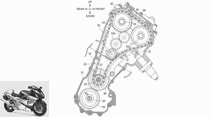
Honda Europe
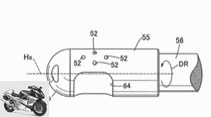



6th pictures
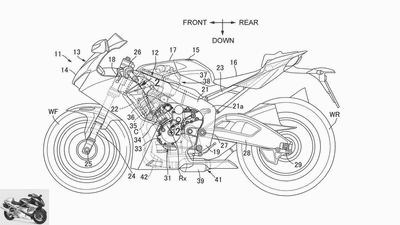
Honda Europe
1/6
For a possible use in a Fireblade of the future, Honda has had a special antechamber technology protected. Honda has experience with this from Formula 1.
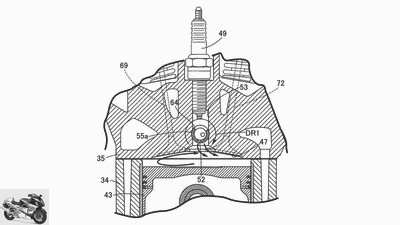
Honda Europe
2/6
The centerpiece is shaft # 55a, which serves as an antechamber and is driven by the camshaft.
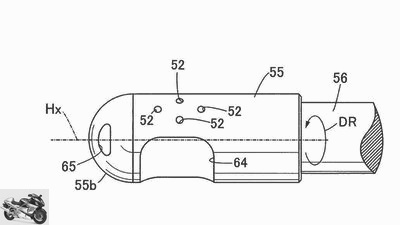
Honda Europe
3/6
The main opening # 64 serves the ignited pre-chamber mixture as a flashover into the main combustion chamber with the lean main mixture. The gasoline is fed from an additional injector through opening # 65. Bores # 52 serve as overflow channels for the main lean mixture under compression into the pre-ignition chamber.
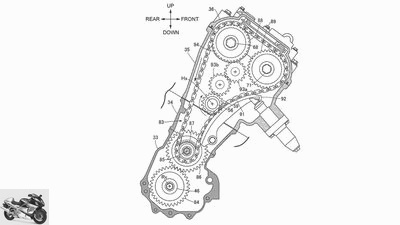
Honda Europe
4/6
Via crankshaft # 85, the timing chain drives the camshafts. The antechamber appears to be driven directly by the camshafts via intermediate gear # 93 a and b. A drive directly on the tensioning blade via the timing chain would make little sense in terms of wear.
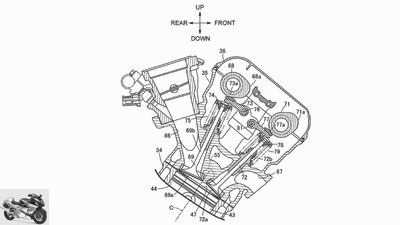
Honda Europe
5/6
The main injection continues to work as an intake manifold injection, the injection of the prechamber is probably located between the two inlet ports.
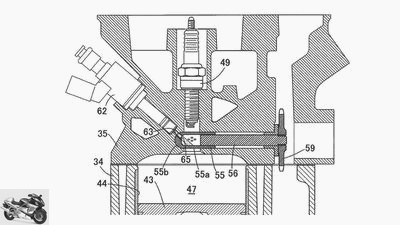
Honda Europe
6/6
The moment of injection of gasoline in the antechamber. At the same time, the piston is in the upward movement for compression.
motorcycles
Pre-chamber ignition at Honda before the comeback
Honda patent for pre-chamber ignition
Formula 1 ignition for Honda Fireblade
Honda has a patent for the use of pre-chamber ignition in the construction of modern motorcycle engines. This type of ignition improves the combustion efficiency enormously, which can mean less fuel consumption. Pre-chamber ignition is widespread in Formula 1 and there is also a bit of two-stroke technology.
Jens Kratschmar
December 23, 2020
Antechamber, rotary valve? Everything has been heard before, but not in connection with modern engines or even Formula 1. But since the introduction of the V6 engines with only 1,600 cubic capacity and the already missing refueling stops in Formula 1, the engine manufacturers have been forced to be efficient – and this is so the prechamber ignition a key.
Pre-chamber ignition? What’s this?
The engine continues to work in four cycles. The piston sucks in air via its downward movement and the inlet valves are open, and the main injection adds fuel. An ignitable, but rather lean mixture is produced. In a conventional Otto engine, such a mixture would tend to spontaneously ignite, and the engine would knock or ring. Neither desired nor without consequential damage to the engine.

Honda Europe
The moment when the gasoline is injected into the prechamber. At the same time the piston is in the upward movement for compression.
This is where the Honda patent comes in. Above the actual combustion chamber in the cylinder head there is a pocket in which another injection nozzle and the only spark plug are located. During the compression stroke, a small amount of very rich mixture is also generated here and ignited by a spark plug. This combustion then ignites the lean mixture in the combustion chamber. The purpose behind this is to ignite the lean mixture in a timely and controlled manner, using the significantly larger flame of the pre-chamber combustion. Something that a single spark plug cannot do with its tiny spark. Without an antechamber: The lean mixture would only burn in a controlled manner in the vicinity of the ignition spark; undesired spontaneous ignition is unavoidable in other areas of the combustion chamber. The solution would be to use several spark plugs (double ignition), but their size would require too much space in the combustion chamber in a conventional design, which in turn would significantly reduce the valve diameter.

Honda Europe
The main injection continues to work as an intake manifold injection, the injection of the prechamber is probably located between the two inlet ports.
What’s the point?
In theory, engine builders would like to build an engine that runs on as much air and as little gasoline as possible. So with a very lean mixture, as this is similarly rich in energy, but requires significantly less gasoline than the stoichiometric mixture in the perfect ratio of 14.7: 1. Since such a lean mixture tends to ignite itself in an uncontrolled manner long before reaching top dead center at higher speeds and increasing compression, this is difficult to deal with in practice. So there needs to be a way to burn a lean mixture with a large flame just before spontaneous ignition, and thus use less fuel with the same power, but protect the engine from the dangerous knocking.
Comeback of the rotary valve engine?
Two-stroke youngsters should have their hearts pounding now. Honda brings the rotary valve back. So at least a variety of it. As an antechamber itself, Honda is planning a rotating sleeve that runs over the camshaft drive, i.e. also at at least half the engine speed. Visually, this antechamber with its different bores and outlet openings looks like a mixture pipe from a carburetor, and the function is even similar.
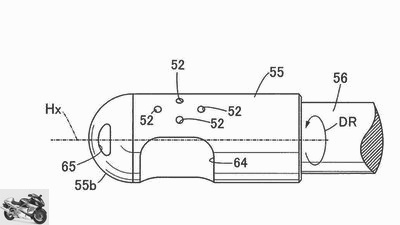
Honda Europe
The main opening # 64 serves the ignited pre-chamber mixture as a flashover into the main combustion chamber with the lean main mixture. The gasoline is fed from an additional injection nozzle through opening # 65. Bores # 52 serve as overflow channels for the main compression lean mixture into the pre-ignition chamber.
Depending on the work cycle, the distinctive main opening (# 54) faces the combustion chamber or the spark plug, so that it is either vented in the exhaust cycle or the prechamber mixture is ignited in the compression cycle. The small bores # 52 serve as transfer channels for the lean main mixture in the compression stroke, as it were, the combustion air of the premix. Gasoline is injected into the compression stroke through opening # 65 to mix the rich premix. The spark plug ignites the mixture in the prechamber, the main opening # 64 rotates towards the combustion chamber, the flame front ignites the lean main mixture just before the piston top dead center. Voila.

Honda Europe
Via the crankshaft # 85, the timing chain drive # 87 drives the timing chain to the camshafts. The antechamber appears to be driven directly by the camshafts via the intermediate gear # 93 a and b. A drive directly on the tensioning blade via the timing chain would make little sense in terms of wear.
Conventional design of the engine
The present patent drawings show an otherwise conventionally constructed reciprocating piston engine with two overhead camshafts with spring-loaded valves controlled by rocker arms. It is driven by a control chain that also controls the antechamber. Interesting, however, is the compact cylinder head with the antechamber openings directly between the valve seats.
Conclusion
The pre-chamber existed in diesel for almost 80 years and the mechanical sophistication of the two-stroke era is undisputed. A combination of both to make the future of the combustion engine tangible is therefore very welcome and for the technology nerds among us food for the soul.
Related articles
-
Honda CBF 600-S in used advice
manufacturer counselor Used purchase Honda CBF 600 / S in used advice Second-hand advice: Honda CBF 600 / S The Honda Tourer as a used one The cliche is:…
-
Honda Africa Twin with 265,000 kilometers
archive Sports & scene Honda Africa Twin with 265,000 kilometers Desert (s) stories Honda Africa Twin with 265,000 kilometers It was eating sand in the…
-
Honda NR 750 with oval piston engine
Honda counselor technology & future Honda NR 750 with oval piston engine Motorcycle story Honda NR 750 with oval piston engine In 1991, Honda presented a…
-
fact motorcycles Comparison test: Honda CBR 600 RR, Kawasaki ZX-6R, Suzuki GSX-R 600, Triumph Daytona 675, Yamaha YZF-R6 Comparison test: Honda CBR 600…
-
Yamaha 7th pictures Yamaha 1/7 In PS 7/2015, reader Gerrit Hawich asked about the function and background of the Yamaha R1 engine with crossplane…
-
counselor Used purchase Used advice Honda CB 500 Used advice Honda CB 500 From the same mould Honda’s new model in the inexpensive entry-level class had…
-
Aprilia NA 850 Mana and Honda NC 700 S DCT in the test
jkuenstle.de 12th pictures jkuenstle.de 1/12 Aprilia NA 850 Mana (variator) and Honda NC 700 S DCT (dual clutch transmission) – two automatic motorcycles…
-
Endurance test final balance: Honda Fireblade
Bilski motorcycles Endurance test final balance: Honda Fireblade Endurance test final balance of the Honda Fireblade Conclusion after 50,000 test…
-
Big bikes from Honda, Suzuki, Kawasaki and Yamaha
archive counselor Used purchase Big bikes from Honda, Suzuki, Kawasaki and Yamaha Buying advice: big bikes The big bike generation from 1984 Content of…
-
Driving report: Honda CRF 450 R
motorcycles Enduro Driving report: Honda CRF 450 R Driving report: Honda CRF 450 R well finally The waiting is over. Much later than expected, Honda…